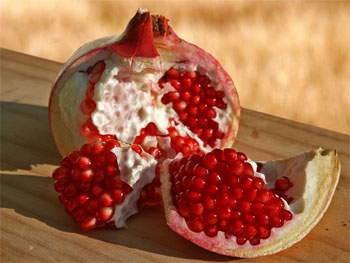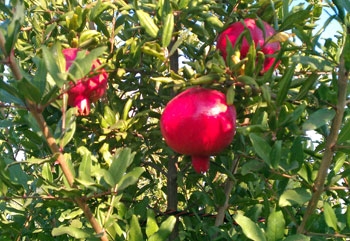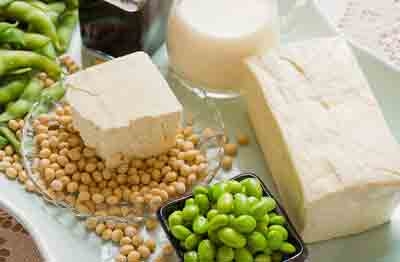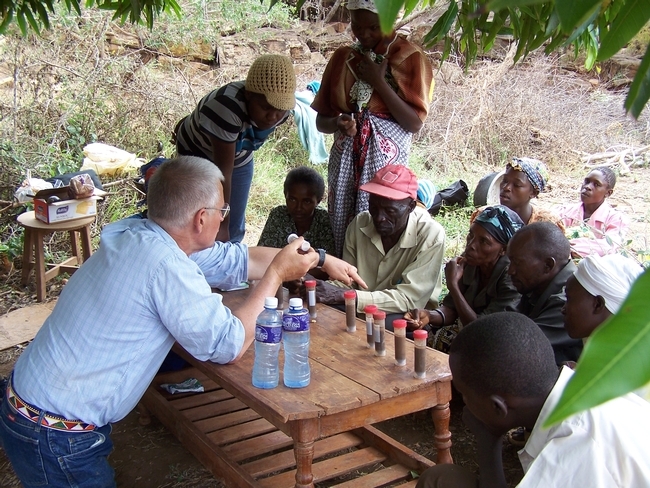UC Food Blog
Time for a new citrus variety in your backyard?
To me, one of the best things about fall and winter in California is that these seasons herald the beginning of citrus season. Each November, I anxiously await the arrival of the Satsuma Mandarins at the farmer's market, and during their short but delicious season we indulge in a 10-pound bag of the little gems every week.
We have three kinds of citrus growing in our backyard, (sadly no Satsumas), and I secretly enjoy calling family back in Colorado when I know it's snowing to report that we are enjoying juice squeezed from oranges picked from our tree that morning.
If you enjoy growing your own citrus (even without the guilty pleasure of tormenting your relatives) you'll want to check out the new UCANR publication Tried and True or Something New? Selected Citrus Varieties for the Home Gardener. This free, downloadable publication gives side-by-side comparisons of old backyard favorites to newly developed varieties suitable for home growers.
The guide includes ripening information for Riverside, but gardeners in subtropical climate zones statewide can enjoy success with most of these varieties.
From blood oranges to citrons, kumquats to 'Kaffir' limes, there's something different here for every gardener. Hmmmm, I think I need to find a place in our yard for a "Tahoe Gold!"
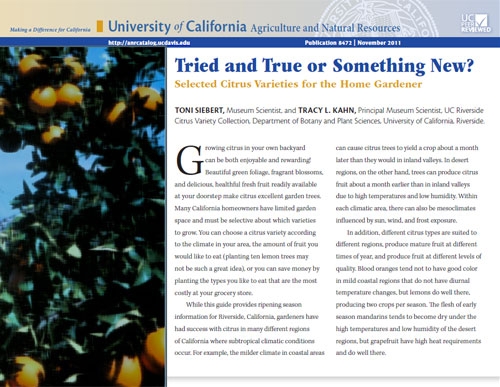
TriedandTrue
The colorful, healthful pomegranate is a good food and lovely landscape plant
A jewel-toned garnish for California cuisine, antioxidant-rich elixir of good health, drought-resistant tree ideal for desert-like regions in California, the pomegranate has inner beauty and outward resiliency driving its growing popularity.
Pomegranates have been cultivated since ancient times, and are referred to poetically in texts ranging from the Bible to Shakespeare’s Romeo and Juliet. They are unusual among California fruit. Tough, leathery skin protects bright red, tart-sweet juice sacs, called arils, which are separated in groups by white spongy tissue. Inside each sac is an edible seed which contains fiber and unsaturated fat. The red pulp is a good source of potassium and vitamin C.
More a large shrub than a tree, with multiple trunks reaching a height of 15 to 20 feet, pomegranates are adapted to regions with cool winters and hot summers. Beautiful shiny foliage and a long flowering season make them attractive additions to coastal, inland valley and desert landscapes. Pomegranates tolerate a wide range of soil types, but prefer deep, well-drained loams. The best time to plant is in late winter or early spring – just before they leaf out.
Data about the scope of California commercial pomegranate production is hard to find. USDA stopped collecting pomegranate data in 1989 and CDFA groups pomegranates with kumquats, loquats, persimmons, prickly pears and other unusual fruit. UC Cooperative Extension farm advisor Maxwell Norton said county pesticide registration data indicate that five Central Valley counties – Kern, Fresno, Madera, Kings and Tulare – have about 35,000 acres planted to pomegranate. About 500 acres are planted in other counties combined. Kern County has the highest production with about 17,000 acres producing fruit valued at $115 million per year.
UC Cooperative Extension farm advisor Paul Vossen suggests the following standard varieties for backyard plantings:
- Ambrosia – Huge fruit, pale pink skin, similar to Wonderful
- Eversweet – Very sweet. Red skin, clear juice. Good for coastal areas
- Granada – Deep crimson fruit color. Matures early, but needs heat
- Ruby Red – Matures late, but not as sweet or colorful as Wonderful.
- Wonderful – Large, deep red fruit, large, juice red kernels. Small seeds.
For eating or juicing, select pomegranates at grocery stores by weight, not color. The heavier the pomegranate, the more juice inside. Some consumers are deterred from purchasing and eating the raw fruit because they believe it’s difficult to prepare. UC Master Food Preserver Geri Scalzi gives five simple steps that make eating fresh pomegranate easy:
- Cut off the top half an inch below the crown. Four to six sections of pomegranate arils divided by white membrane will be visible.
- Score the leathery skin with a sharp knife along each section.
- Break the pomegranate apart along the score lines. This can be done under water to prevent squirting pomegranate juice, which tends to stain clothing.
- Loosen arils and membranes and drop them into water. The arils will sink, the membranes will float. Skim off the membranes with a slotted spoon.
- Pour the arils and remaining liquid through a strainer.
The pulpy seed sacs are then ready to be eaten plain, tossed in salads, stirred into yogurt or sprinkled over cereal.
For more information on pomegranate production, attend a public meeting at the UC Kearney Agricultural Research and Extension Center, 9240 S. Riverbend Ave., Parlier, from 10 a.m to 1 p.m. Tuesday, Nov. 29. The following topics will be covered:
- Insect pest update, integrated pest management entomologist Walt Bentley
- Black heart disorder and tree decline issues, UC Davis plant pathologist Themis Michailides
- Interesting selections in the USDA germplasm collection, USDA national clonal germplasm representative Jeff Moersfelder
- Irrigation, fertigation & nitrogen use efficiency with drip irrigation, Claude J. Phené, USDA-ARS
- Summary of acreage trends, Merced County farm advisor Maxwell Norton
RSVP to Yolanda Murillo at ymurillo@ucdavis.edu or (559) 600-7285. The $10 registration fee may be paid at the door with cash or check. More information.
Are weeds taking over your garden?
My calendar says November but the weeds in my garden think it’s spring. That nice rain last month followed by warm, sunny days has prompted them to grow like, well, weeds and that’s not good news for my winter crops.
What’s a gardener to do?
Like so many other gardeners, I turned to the folks at the UC Davis Weed Science Program. Housed in the UC Davis Department of Plant Sciences, the “weeders” are experts at helping growers and gardeners improve plant production by controlling weeds.
What are the most effective organic tools for controlling weeds? That’s what I, and thousands of others, want to know. You don’t have to be an organic grower to seek organic tools for fighting weeds. Synthetic herbicides come with a cost to growers and the environment, so more and more farmers are seeing the value in employing organic tools with or without other means.
Which tools work the best in which situations? Here’s a quick overview, courtesy of Cooperative Extension Specialist Tom Lanini, who specializes in weed control in vegetable crops.
Mulches – Researchers test them all – plastic, bark, wood chips, other porous material, even what they call live mulches like clovers and fava beans. Mulches block light, which weeds need to grow. “I think mulches can be the best organic option for fighting weeds, especially for vines and trees,” Lanini says. Mulches are also a key weed-fighting component in organic strawberry and many other crops.
Organic sprays – Coverage is the key. “No matter what type you use – oils, soaps, acids, etc. – if you don’t spray-to-wet, 100 percent coverage, the weeds will grow back,” Lanini says. Temperature and the age of the weed matters too. Apply in temperatures above 75 degrees when weeds are very young – about a week old – for best results. Broadleaf weeds are easier than grasses to control with sprays.
The most effective organic spray Lanini has found so far is good old-fashioned vinegar, the kind you use to make pickles. The trouble with that is, the FDA has yet to approve it for controlling weeds. “You can eat it, but can’t spray it on your weeds,” as Lanini says. There are herbicides with vinegar as their active ingredient, but they are much more costly than household vinegar.
Flamers – These propane-fueled devices quickly raise the temperature of the weed to more than 130 degrees, rupturing its cell membranes. Grasses are hard to kill by flaming because the growing point is protected underground. Flamers require quite a bit of fuel, which can be costly.
Solarization has become an important method of weed and disease control in organic desert vegetable crops. In this system, four to six weeks of solar heat under clear plastic film will kill weed seeds and pathogen propagules.
Cultural practices are extremely important in all vegetable crops especially in organic crops. Crop rotations result in shifting environments that do not favor any one weed. Use of preplant irrigation followed by shallow tillage, or flaming is a very effective method of reducing the potential weed infestation during the crop cycle.
Weeding and thinning by tool or machine is a time-honored solution. Never underestimate the value of a hoe.
You can read more about the UC Weed Science Program here and access the Weed Research and Information Center web site here.
For more detail on weed management for organic vegetable crops, Click here.
Antioxidants in soy protein may help protect against heart disease
Diet and lifestyle choices are major factors contributing to the risk of cardiovascular disease, which is responsible for more deaths in the United States than any other cause.
One dietary component that has received considerable attention for its potential heart-protective effects is soybeans, which contain lean vegetable protein, dietary fiber and antioxidants called isoflavones.
In a recent issue of the University of California’s California Agriculture journal, scientists reviewed research concerning the relationship between soy and heart disease. Several potential mechanisms have been identified for the observed cardioprotective effects of soy, including cholesterol-lowering properties, antioxidant activity and gene regulation.
“Soybeans and foods made from soy are the major source of isoflavones, which serve as antioxidants, scavenging and neutralizing free radicals that might otherwise cause inflammation and increase the risk of heart disease,” wrote Emily R. Cena, senior writer, and Francine M. Steinberg, professor and chair of the UC Davis Department of Nutrition.
Soy acts like compounds similar to the hormone estrogen, such as blood vessel dilation and gene regulation. “Some health concerns have been raised related to soy's estrogenlike properties, particularly with regard to breast cancer risk, but these concerns were beyond the scope of the current article,” the authors wrote.
The preponderance of research shows that soy isoflavones increase levels of cardioprotective HDL (“good”) cholesterol and decrease levels of LDL (“bad”) cholesterol, thereby lowering the risk of heart disease. Soy may also help ameliorate metabolic syndrome, a constellation of risk factors including abdominal obesity, high blood pressure, insulin resistance and alterations in blood lipids that result in increased risk of heart disease and type 2 diabetes.
A current research project funded by the UC Davis Center for Health and Nutrition Research is investigating the effects of consuming whole soy foods on biomarkers of cardiovascular risk in individuals with metabolic syndrome; it may be completed in 2012.
“Soy isoflavones have a broad variety of biological actions,” Cena and Steinberg wrote. “The beneficial effects of soy are modest compared to pharmacological treatment, such as statin drugs. However, the cumulative effects over a lifetime are likely to be significant.”
The authors highlight epidemiological studies suggesting that Asian populations consuming large amounts of soy have lower rates of cardiovascular disease than Western populations. For example, in the mid-1990s a meta-analysis of 29 clinical trials found that compared to animal protein, soy protein significantly reduced blood levels of several fats (total cholesterol, LDL cholesterol and triglycerides). This prompted the U.S. Food and Drug Administration to approve the current health claim that 25 grams of soy protein per day, as part of a diet low in saturated fat and cholesterol, may reduce the risk of heart disease.
The review article on soy and heart health was featured in a special issue of California Agriculture journal, “Food as medicine: Can what we eat help cure what ails us?”
UC researchers share knowledge in Kenya’s Kitui District
In June of this year, three University of California scientists went to the Kitui District of Kenya on a USAID mission.
Food and water scarcity are simply a part of life for most in this region. Since 1992 the Sahelian Solution Foundation (SASOL) has been constructing dams and working with Kitui communities to address water scarcity and issues of community development and agricultural production.
Agricultural production in Kenya is full of challenges. Water is carried by hand from wells or dams for household and agricultural needs. Previous to this mission, crops were watered inefficiently by flooding small basins. Nitrogen tests in some locations revealed levels at which most vegetable crops would be nitrogen deficient. Some of the villages have no road access.
UC’s Steve Fennimore, Jeff Mitchell, and Oleg Daugovish went to help SASOL and the people they serve make better use of their resources.
They met with village leaders and SASOL personnel in Kitui. Here they provided training and demonstrations covering topics including:
- Demonstrations of gravity-flow drip irrigation systems from water tanks to individual beds with irrigation lines
- Discussed use of mulches on soil to minimize evaporation and enhance soil conservation
- Solarization, nursery for transplants, diseases and insects, training tomato plants and culture
- Soil types, determination of soil moisture, quick nitrogen test, use of cover crops and mulches
- Water quality (pH, hardness, salts), organic fertilizers, collection and use of urine as a rapidly available nitrogen source.
Later the information was shared in the Maito village, where onions, green kale and green grams (Phasleolus aureus) are grown. The next day found the group in the Kituvwi village, where due to poor crop production, meals are currently limited to once a day. The following day was spent in the Kathayoni village. Farmers in the Kathayoni village grow kale, onions and tomatoes.
SASOL will continue the training for members in villages not reached during this visit.
The majority of farmers in the Kitui District are women. Information was well received in all locations and many questions were asked. At each village the scientists were fed a stew of corn and beans, supplemented by avocado slices or bread, with tea and milk to drink.
The last day time was spent at the South East University College. Potential for agricultural experimentation and greenhouses was discussed, and UC scientists gave a seminar about UCCE function and on anaerobic soil-borne pest control.


